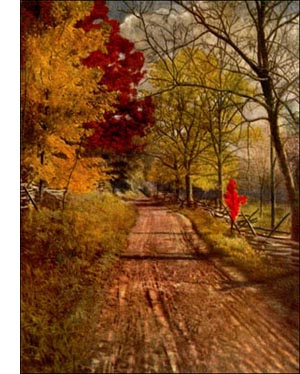Post Oak or Iron Oak Tree
 Post Oak, Iron Oak (Quercus minor, Sarg.)-A dense, round-topped tree, scrubby or 40 to 50 feet high, with low, crooked branches and stubby, rough twigs. Bark greyish brown, deeply furrowed, scaly wide ridges; branches brown; twigs brownish with yellow fuzz. Wood pale brown, close grained, hard, strong, heavy, durable in contact with soil. Buds small, round, rusty, downy. Leaves 4 to 5 inches long, clustered, abundant, stiff, rough, dark, shining above, brown woolly beneath, obovate, with 5 to 7 unequal, square-tipped lobes separated by wide sinuses, hanging on all winter, turning yellow or pale brown. Flowers in May with half-grown leaves; staminate catkins, 3 to 4 inches long, yellow, hairy; pistillate flowers, almost sessile; stigmas bright red. Acorns annual, 3/4 to 1 inch long, ovoid, brownish, in shallow cup of loose, blunt-pointed scales, enclosing only 1/3 to 1/2 of the nut. Kernel sweet. Preferred habitat, dry, sandy or rocky soil. Distribution, southern Massachusetts to northern Florida; west to Missouri and Texas. Especially common in the Southwest. Uses: Hardy ornamental oak; grows well in dry, rocky soil. Lumber used largely for railroad ties, fuel and fencing; also for cooperage and construction. Seldom distinguished in the trade from white oak.
Post Oak, Iron Oak (Quercus minor, Sarg.)-A dense, round-topped tree, scrubby or 40 to 50 feet high, with low, crooked branches and stubby, rough twigs. Bark greyish brown, deeply furrowed, scaly wide ridges; branches brown; twigs brownish with yellow fuzz. Wood pale brown, close grained, hard, strong, heavy, durable in contact with soil. Buds small, round, rusty, downy. Leaves 4 to 5 inches long, clustered, abundant, stiff, rough, dark, shining above, brown woolly beneath, obovate, with 5 to 7 unequal, square-tipped lobes separated by wide sinuses, hanging on all winter, turning yellow or pale brown. Flowers in May with half-grown leaves; staminate catkins, 3 to 4 inches long, yellow, hairy; pistillate flowers, almost sessile; stigmas bright red. Acorns annual, 3/4 to 1 inch long, ovoid, brownish, in shallow cup of loose, blunt-pointed scales, enclosing only 1/3 to 1/2 of the nut. Kernel sweet. Preferred habitat, dry, sandy or rocky soil. Distribution, southern Massachusetts to northern Florida; west to Missouri and Texas. Especially common in the Southwest. Uses: Hardy ornamental oak; grows well in dry, rocky soil. Lumber used largely for railroad ties, fuel and fencing; also for cooperage and construction. Seldom distinguished in the trade from white oak.The post oak looks like a tree with its trunk buried in the ground. Its head is broader at the top, no matter how it is crowded in the woods, and the multitude of stubby branches are "full of elbows," i. e., the angles between limb and branch are all wide open, giving the tree a distinct character.
The foliage is another means of knowing the post oak. At a distance it looks almost black in summer. Come nearer. The leaf lining is coated with greyish pubescence. The texture of a leaf makes you cringe as you crumple it in your hands. It is thick and leathery, and roughened above by wonderfully branched hairs, that are star-like under a magnifier. Three broad, squarish lobes form the top, and the blade tapers from these to the stubby petiole. Sometimes there are five lobes altogether; sometimes only the three at the top. Each twig holds out a cluster of these leaves, like a fan. In the autumn they turn yellow or brown, but the twigs will not let them go. A characteristic post oak is densely leafy all winter, and until the opening shoots push the stubborn old leaf stalks out of the way. This habit gives the post oak much of its picturesqueness in winter, for the foliage does not entirely conceal its ruggedness and crookedness of limb.
The acorns are trim and dainty. The annual crop rarely fails. They are very sweet, and in the old days were devoured by wild turkeys. Then people knew it as the turkey oak.
The names of this species, iron oak and post oak, indicate the reputation of its wood for durability in contact with the soil and with water. Post-oak staves from Baltimore were preferred in the West Indian trade in sugar, rum and other barrelled commodities. "Knees" of post oak are always in demand, and, where trees attained sufficient size, the timbers are used in the framework and sides of ships.